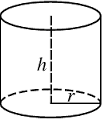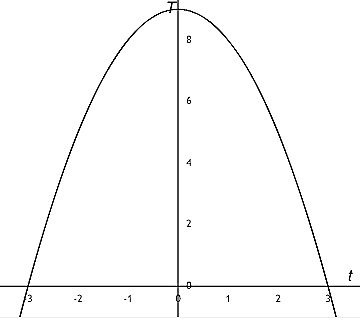General Educational Development Test: Social Studies, Language Arts - Writing, Science, Language Arts - Reading, Mathematics v1.0
Question 1
The diameter of one bicycle wheel is 28 inches and its spokes run from the hub (or center) to the edge of the rim. The diameter of another bicycle wheel 21 inches. What is the difference in inches between the length of the spokes of the two wheels?
- A. 7
- B. 3.5
- C. 4.5
- D. 12
- E. 8
Answer : B
Explanation:
The spoke is equivalent to the radius, which is the diameter / 2.
Therefore, the spoke for the 28-inch wheel is 14 inches.
The spoke for the 21-inch wheel is 10.5 Inches.
14 גˆ’ 10.5 = 3.5-inch difference between spokes.
Question 2

Solve for b:
a = 14
b = ?
c = 50
- A. b = 44
- B. b = 50
- C. b = 48
- D. b = גˆ’48
Answer : C
Explanation:
Use the equation a -
= c
, plug in the known values, and solve.
Question 3
Two supplementary angles have measures of 9x degrees and 3x degrees. What is the measure of the longer angle?
- A. 180 degrees
- B. 45 degrees
- C. 135 degrees
- D. 15 degrees
Answer : C
Explanation:
Supplementary angles must add up to 180 degrees. Using that logic, you can solve for x.
9x + 3x = 180
12x = 180
x = 15
Now plug 15 in to 9x and 3x individually, and your two angles will be 135 degrees and 45 degrees. Answer ג€135 degreesג€ is correct since you want the longer angle.
Question 4
Determine the coordinates for the midpoint of a segment with the following endpoints: (12, גˆ’8) and (8, גˆ’4).
- A. (גˆ’10, 6)
- B. (6, גˆ’10)
- C. (גˆ’6, גˆ’10)
- D. (10, גˆ’6)
Answer : D
Explanation:
The following can help you determine midpoint coordinates:
(x
+x
) / 2,
(y
+y
) / 2
Question 5
A triangle has an area of 110 square inches and a base of 15 inches. Which answer best pinpoints the height?
- A. 14 inches
- B. 18 inches
- C. 18.66 inches
- D. 14.66 inches
Answer : D
Explanation:
To determine the area of a triangle, use the equation
A = (1/2)bh (or base times height)
The problem gives you the area as being 110 square inches. Plug that in for A.
Next, plug in 15 inches for base (also given) and solve for h.
Question 6
A great circle of a sphere lies on its surface and contains its center. What is the circumference of a great circle of a sphere that has a surface area that measures
1,476 square centimeters?
NOTE: ֿ€ equals 3.14.
- A. Approximately 68.1
- B. 74.5
- C. 86.1
- D. 54.7
Answer : A
Explanation:
SA = 4ֿ€r -
finds the radius.
4(3.14)r
= 1,476cm
12.56r
= 1,476cm
r
= 117.51592356687898
r = 10.840476168825749 (or 10.84)
Place the value of the radius in the circumference formula (C = 2ֿ€r)
C = 2 ֳ— 3.14 ֳ— 10.84 = 68.0752 or approximately 68.1.
Question 7
The cylinder below has r = 10 inches and a volume of 6283 cubic inches to the nearest cubic inch. Find the height of the cylinder to the nearest inch.

- A. 25 inches
- B. 3 inches
- C. 10 inches
- D. 20 inches
Answer : D
Explanation:
The volume of this cylinder is 6283.
ֿ€r
h = 6283. h is the height. ֿ€ is 3.14...
h = 6283 ֳ· ֿ€ ֳ· 100 = 19.999....
h = 20
The height of the cylinder is 20 inches.
Question 8
In the diagram below, which line has a positive slope?

- A. AB
- B. AD
- C. AC
- D. DB
Answer : C
Explanation:
The coordinates of A are (1, 2), the coordinates of B are (3, 2). The slope of AB is (2 גˆ’ 2) / (3 גˆ’ 1) = 0
The coordinates of A are (1, 2), the coordinates of D are (גˆ’2, 4). The slope of AD is (4 גˆ’ 2) / ( גˆ’2 גˆ’ 1) = גˆ’4/3
The coordinates of A are (1, 2), the coordinates of C are (2, 4). The slope of AB is (4 גˆ’ 2) / (2 גˆ’ 1) = 2
The coordinates of D are (גˆ’2, 4), the coordinates of B are (3, 2). The slope of DB is (2 גˆ’ 4) / (3 ג€" (גˆ’2)) = גˆ’4/5
Question 9
In the diagram below, what are the coordinates of the mirror image of the point B in the x-axis?

- A. (3, גˆ’4)
- B. (3, גˆ’2)
- C. (גˆ’3, 2)
- D. (2, 3)
Answer : B
Explanation:
If B is reflected in the x-axis its x-coordinate will not change but it will be as far below the x-axis as it currently is above the x-axis. Its coordinates, after reflection, will be (3, גˆ’2).
Question 10
A graph of the temperature T (degrees Fahrenheit) in a refrigerator t hours after midday.

What is the equation of the axis of symmetry of this graph?
- A. T = 9
- B. t = 3
- C. T = 0
- D. t = 0
Answer : C
Explanation:
It is clear from the diagram that the T-axis is the mirror line or axis of symmetry of this diagram. The equation of the T-axis is t = 0. The equation of the axis of symmetry of this graph is t = 0.
Question 11
Refer to the following diagram:

It is necessary to find the times when the temperature is 8ֲ° F. Which of the following is the correct equation to do this?
1. 9 גˆ’ t = 8
2. 9 + t
= 8
3. 9 גˆ’ t
= 8
4. 9t גˆ’ t
= 8
- A. 1
- B. 2
- C. 3
- D. 4
Answer : C
Explanation:
It is apparent from the graph that it is not linear hence the answer cannot be 1. If an attempt is made to solve 2 it will be found there is no real solution. One of the solutions to 4 is 8, which gives a negative value. 3 is the only possible solution.
Question 12
Which of the following is the equation of the straight line joining the points on the graph corresponding to t = 2 and t = 1?

- A. T + 3t = 11
- B. T גˆ’ 3t = 1
- C. T + 11t = 3
- D. T + 3t = 1
Answer : A
Explanation:
The point on the graph corresponding to t = 1 is (1,8).
The point on the graph corresponding to t = 2 is (2,5).
The slope of the straight line joining them is (5 גˆ’ 8) ֳ· (2 גˆ’ 1) = גˆ’3.
The equation is T = גˆ’3t + c -
As (2,5) lies the line we can substitute for t and T.
5 = גˆ’3 ֳ— 2 + c
c = 11
Equation is T = גˆ’3t + 11 which is the same as (A).
Question 13
The following two questions relate to the sphere shown below:

The formula for the volume V of the sphere = 4ֿ€r
/ 3. Which of the following is the closest approximation to the volume when r, the radius, is 11 inches?
- A. 6000 cubic inches
- B. 5590 cubic inches
- C. 5573 cubic inches
- D. 5000 cubic inches
Answer : C
Explanation:
It is necessary to substitute 11 for r in the formula. The calculation is V = 4/3 ֳ— (ֿ€ = 3.14) ֳ— 113 = 5572.45....... Clearly the closest approximation to this is 5573 cubic inches.
Question 14
If the radius of the sphere were doubled by what factor would the surface area be enlarged?

Note: The formula for the surface area S of the sphere = 4 ֳ— ֿ€ ֳ— r
- A. 2
- B. 4
- C. 8
- D. 16
Answer : B
Explanation:
If r = 1 then the surface area of the smaller sphere is 12.56...... If the radius is doubled the surface area is 50.26...... The factor is 50.26... ֳ· 12.56.... = 4. The surface area is enlarged by a factor of 4.
Question 15
The graph below is part of the graph of the function T = (t + 1) (t גˆ’ 3) for the temperature in a refrigerator for time t hours after midday.

For which set of t values is the temperature below 0?
- A. (1, 3)
- B. (גˆ’1, 3)
- C. t ג‰¥ 3
- D. t = 1
Answer : B
Explanation:
Although T is negative for 1 < t < 3, when t = 3, T = 0.
T ג‰¥ 0 for t ג‰¥ 3 -
T > 0 for t < גˆ’1.
T < 0 or negative when גˆ’1 < t < 3